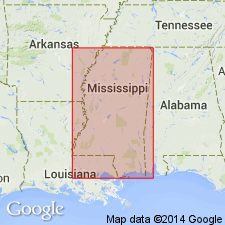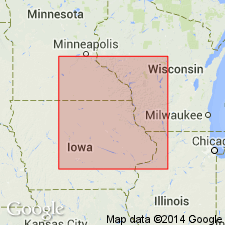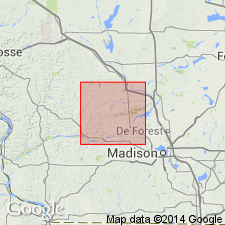
- Usage in publication:
-
- Windrow formation
- Modifications:
-
- Named
- Dominant lithology:
-
- Gravel
- Chert
- Quartz
- AAPG geologic province:
-
- Wisconsin arch
Summary:
Windrow formation described as widely scattered patches of quartz and chert gravels, with associated limonite deposits, which occur on tops of high elevations throughout the driftless area of upper Mississippi Valley and adjacent glaciated region of west-central WI, and parts of southeastern MN and northeastern IA. The chert pebbles contain fossils, the youngest of which are certainly Silurian. The formation was river-deposited at a time far antedating the Pleistocene and not necessarily connected with peneplanation, but no definite age can be assigned to it.
Source: GNU records (USGS DDS-6; Reston GNULEX).

- Usage in publication:
-
- Windrow formation
- Modifications:
-
- Revised
- Overview
- AAPG geologic province:
-
- Wisconsin arch
Summary:
Windrow formation is here defined to include known deposits of upper Mississippi Valley that are in lithologic and mineralogic conformity with type section as described by Thwaites and Twenhofel (1921) and as described in this paper. Comprises Iron Hill member below and East Bluff member (both new names). Underlain by rocks as old as Precambrian and as young as Devonian. Overlain by deposits as old as Nebraskan drift and as young as recent soil. Available evidence strongly suggests Cretaceous age.
Source: GNU records (USGS DDS-6; Reston GNULEX).

- Usage in publication:
-
- Windrow Formation
- Modifications:
-
- Areal extent
- Revised
- AAPG geologic province:
-
- Wisconsin arch
Summary:
Windrow Formation occurs as small, isolated bodies of stream gravel on uplands in western and southwestern WI and adjacent areas. Only reported occurrence of Windrow in Sauk Co. is on East Bluff, on the east side of Devils Lake gorge (Thwaites and Twenhofel, 1921). Unit here consists of scattered loose pebbles on the surface of the quartzite or lag pebbles in Pleistocene slope deposits. Though Windrow has been correlated with Cretaceous material in IA and MN, authors feel there is no direct evidence for this interpretation. They state that the Windrow may be a valid lithostratigraphic unit, but that it probably includes material of various ages. This gravel, generally found in potholes, is probably the same age as the potholes--Mesozoic to Cenozoic. Andrews' East Bluff Member considered an invalid stratigraphic name. Pebbles observed on East Bluff probably in Pleistocene sediment eroded from the Windrow.
Source: GNU records (USGS DDS-6; Reston GNULEX).
For more information, please contact Nancy Stamm, Geologic Names Committee Secretary.
Asterisk (*) indicates published by U.S. Geological Survey authors.
"No current usage" (†) implies that a name has been abandoned or has fallen into disuse. Former usage and, if known, replacement name given in parentheses ( ).
Slash (/) indicates name conflicts with nomenclatural guidelines (CSN, 1933; ACSN, 1961, 1970; NACSN, 1983, 2005, 2021). May be explained within brackets ([ ]).

